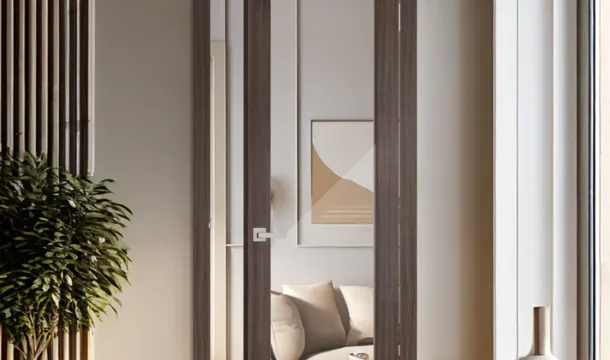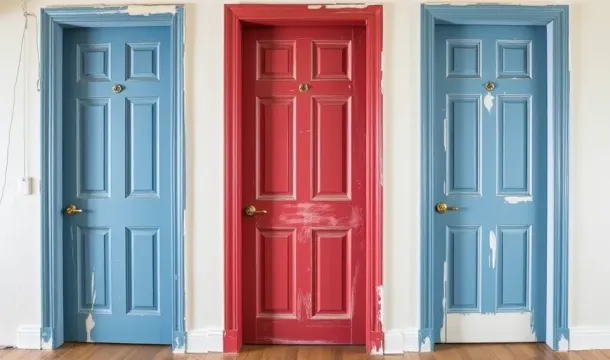Choosing Black Interior Doors Elegant Style or Too Much
Popular Articles
Black interior doors bring a bold statement to any home, combining modern design with timeless elegance. When choosing doors in black, focus on the balance between contrast and cohesion within your overall interior style. Black doors work best in spaces with ample natural light and lighter walls, creating a striking yet harmonious visual effect.
The current trend favors matte or satin finishes for black doors, as they reduce glare and emphasize texture. Pairing black doors with minimalist hardware enhances their sleek appearance without overwhelming the room’s design. Avoid excessive use of dark elements nearby, which can make the space feel heavy or cramped.
Design versatility is another advantage–black doors complement both contemporary and classic interiors. For an elegant, refined look, consider integrating them with neutral palettes and metallic accents. In open-plan homes, consistent use of black doors can unify different zones while maintaining distinct boundaries.
Assessing Room Size Impact
In compact spaces, black interior doors can create a strong focal point without overwhelming the room if paired with lighter walls and minimalistic decor. For rooms under 120 square feet, opt for matte or satin finishes to reduce light absorption and maintain a sense of openness.
Medium-sized rooms (120–250 square feet) allow for bolder black door designs, including panel details or subtle gloss, which complement an elegant style while enhancing depth. Ensure adequate natural or artificial lighting to balance the door’s dark tone.
Larger rooms benefit from black doors as they add contrast and sophistication without shrinking the perceived space. Incorporating architectural elements like molding or glass inserts in black doors enriches the design and reinforces the bold trend without feeling overpowering.
Choosing black doors requires alignment with room proportions: oversized doors in small rooms can feel imposing, while slim black frames in large areas may lack presence. Consistent integration with surrounding finishes ensures that these bold interior elements contribute to a harmonious home design.
Matching Black Doors Colors
Choosing black interior doors requires careful coordination with surrounding colors to maintain an elegant and bold design. Pair black doors with neutral tones such as soft grays, warm beiges, or crisp whites to create balanced contrast that enhances the door’s sleek presence without overwhelming the space. For a trend-forward approach, incorporate deep jewel tones like emerald green or navy blue on walls or accent pieces; these rich hues complement black doors by adding depth and sophistication.
Matte black doors harmonize well with natural wood finishes, especially lighter oak or walnut, offering a modern yet inviting atmosphere. Glossy black doors suit monochromatic interiors featuring varied shades of gray and metallic accents, elevating the overall design to a refined level. Avoid pairing black doors with overly saturated bright colors which can clash and reduce the intended elegance.
When choosing hardware, opt for matte brass or brushed nickel to add subtle warmth or coolness depending on your home’s palette. Consistent door frame color–either matching the door or slightly lighter–ensures a seamless transition within the interior scheme. In open-plan layouts, replicate black elements through furniture or decor to create cohesion and reinforce the bold style choice.
Balancing Light and Shadow
Integrate black interior doors by positioning them where natural or artificial light can highlight their sleek surfaces without overwhelming the space. Use reflective materials like glass panels or mirrors nearby to diffuse shadows and maintain brightness. Pair bold black doors with lighter wall colors and furnishings to create contrast that enhances the design’s elegance while preserving an airy atmosphere.
Consider installing adjustable lighting fixtures such as dimmable sconces or recessed LED strips around the doorframe to control shadow intensity throughout the day. This flexibility supports both dramatic evening moods and functional daylight use, ensuring the black doors remain a sophisticated focal point rather than a dark barrier.
In rooms with limited windows, balance is achieved by adding textured textiles and metallic accents that catch light, softening harsh contrasts created by the black doors. Thoughtful layering of light sources–ambient, task, and accent–helps distribute illumination evenly, preventing the interior from feeling too heavy or closed off.
Choosing black doors as part of a broader trend requires precise calibration between shadow and light; this approach maintains an elegant style while avoiding spaces that feel too bold or oppressive for everyday living.
Material Choices for Black Doors
Selecting the right material for black interior doors impacts durability, style, and maintenance. Solid wood offers a timeless, elegant look with natural grain visible under black finishes, ideal for classic or bold design schemes. Engineered wood products like MDF provide smooth surfaces perfect for deep matte or glossy black paints, supporting contemporary trends while resisting warping in humid conditions.
Metal doors add an industrial edge to interiors, enhancing the boldness of black tones with sleek, reflective qualities. They perform well in high-traffic areas due to strength and low upkeep. For a lighter option, fiberglass doors mimic wood textures and handle moisture effectively, maintaining their black finish without fading.
Maintaining Black Door Surfaces
To preserve the bold design and sleek style of black interior doors, regular care tailored to their finish is necessary. Black surfaces reveal dust, fingerprints, and smudges more visibly than lighter tones, so consistent maintenance enhances both appearance and longevity.
- Dusting: Use a microfiber cloth or a soft duster daily to remove dust without scratching the surface. Avoid rough materials that can dull the finish.
- Cleaning: For routine cleaning, mix mild dish soap with warm water. Apply with a soft cloth and wipe gently, then dry immediately to prevent water spots. Avoid abrasive cleaners or harsh chemicals which damage paint or varnish.
- Spot Treatment: Fingerprints and grease marks require prompt attention. Use a solution of equal parts water and white vinegar applied with a damp cloth for effective removal without harming the door’s surface.
- Avoid Direct Sunlight Exposure: Prolonged sunlight can cause fading or discoloration on black doors; position doors away from intense sun or use window treatments to reduce UV impact.
- Polishing and Protection: For painted black doors, apply a high-quality furniture polish sparingly once every few months to restore shine. For matte finishes, avoid polish and focus on gentle cleaning only.
- Handle Hardware Care: Regularly clean door handles and hinges since dirt buildup here detracts from the overall aesthetic of your interior design.
Choosing durable finishes like semi-gloss or satin on black doors can simplify maintenance while keeping the stylish appeal intact. This approach ensures your home’s black doors remain a bold trend element without overwhelming your interior over time.
Popular Articles

Choosing the Perfect Interior Doors for Your Canadian Home

A Complete Guide to Choosing Interior Doors for Canadian Homes
